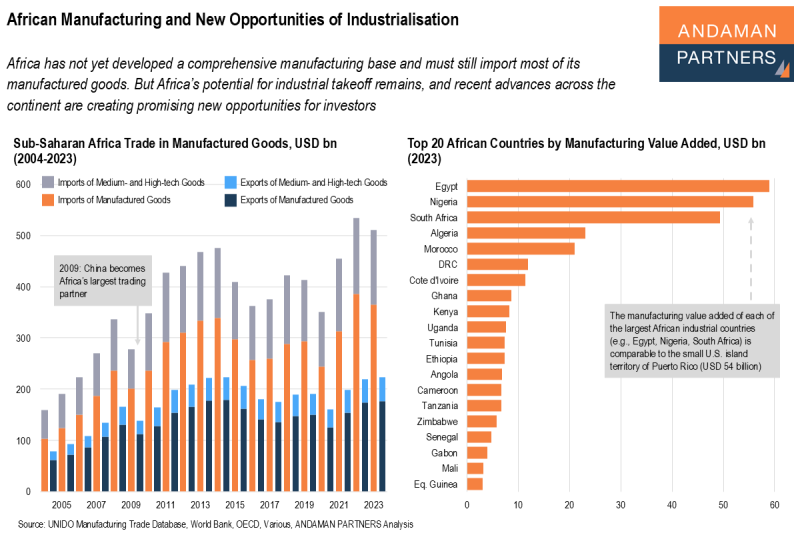The world’s largest economies are located in the Americas, Western Europe and East Asia, but the most dynamic economies with sustained economic growth are clustered in Africa and South, Central and Southeast Asia.
The list of the 20 largest economies in terms of GDP in 2024 presents a familiar picture of the world’s heavyweights, led by the U.S. and China at the top, followed by Germany, Japan and India (India is projected to surpass Japan in 2025), with several economies in Western Europe and Brazil rounding out the top ten.
The economies ranked 11th to 20th include more developed economies, such as Spain, the Netherlands and Switzerland, as well as several large developing economies, including Mexico, Indonesia, Türkiye and Saudi Arabia.
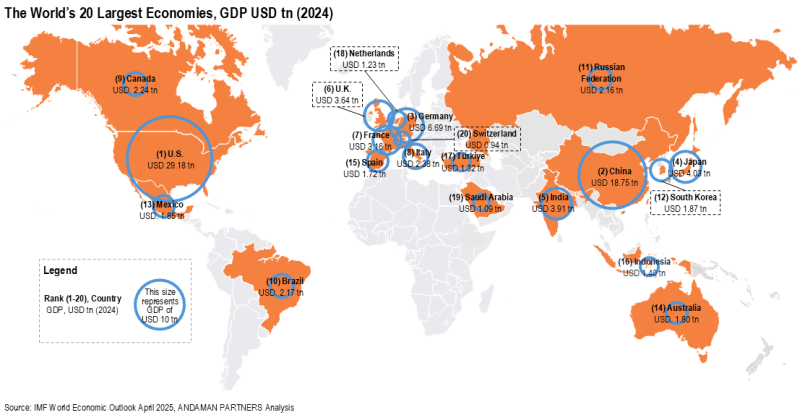
The list of the world’s most dynamic economies, i.e., those that sustained the highest real GDP growth over the last decade (2014-2024), however, includes a range of smaller and less familiar economies clustered in Africa, South, Central and Southeast Asia, as well as the periphery of Europe.
These economies are not the world’s largest by any means, but they play a pivotal role in supporting global economic growth, and are unmistakable hotspots that potential investors must keep their eye on.
Dynamism: The World’s Fastest-Growing Economies
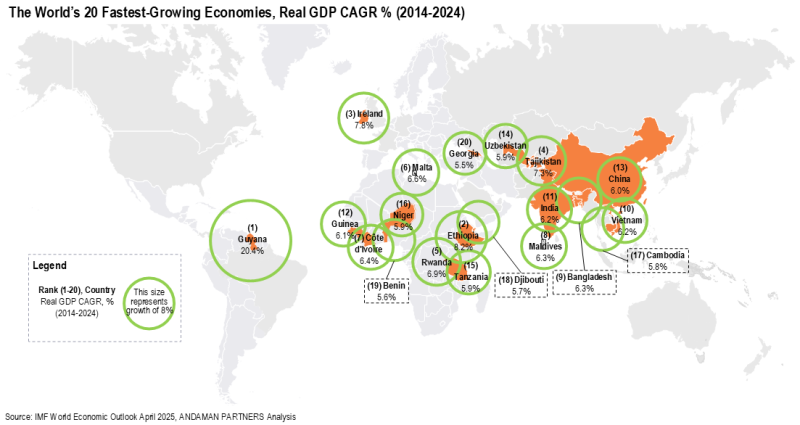
The world’s most dynamic economies are located in entirely different areas of the world map compared to the largest economies. The only major economies on the list of the 20 fastest-growing economies from 2014 to 2024 are Vietnam (ranked 10th), India (11th) and China (13th), which all achieved growth rates of 6%.
Guyana, a country situated on the northern coast of South America and one of the world’s least densely populated countries, achieved the highest real GDP growth rate during this period, at 20.4%, significantly outperforming the growth rates of all other economies. Guyana’s phenomenal growth rate is attributable to the discovery of significant crude oil reserves off its Atlantic coast and the commencement of drilling in 2019. The country’s GDP growth in 2020 increased to 43.5%, and in 2022, it rose to 63.3%.
The Periphery of Europe
Ireland achieved real GDP growth of 7.8%, ranking third overall and the highest in Europe. As an established hub for multinational corporations (MNCs) with favourable tax policies, Ireland serves as a gateway for businesses seeking to operate in the European market. MNCs contribute significantly to Ireland’s strong export growth, which is concentrated in the technology, pharmaceutical and medical technology sectors.
Two other economies on the European periphery made the top 20. The island country of Malta achieved a growth rate of 6.6%, ranking sixth overall, with an economy based on niche services, notably gaming, finance, logistics, tourism, maritime and aviation. Georgia, a country located in the Caucasus region at the intersection of Eastern Europe and West Asia, achieved a growth rate of 5.5% and ranked 20th overall. Georgia’s growth is based on the country’s development as an international transport corridor, as well as its role in oil and gas transit and tourism.
East and West Africa
A total of eight African economies made the top 20, led by Ethiopia with 8.2% (placed second overall) and Rwanda with 6.9% (ranked fifth). Ethiopia’s rapid growth is based on public infrastructure projects, light manufacturing and agri-processing, while Rwanda’s growth is broad-based across services, industry and agriculture, supported by tourism and construction.
Four West African economies made the top 20, led by Côte d’Ivoire, which achieved growth of 6.4% (ranked seventh overall) based on agriprocessing, ports and logistics, and retail and real estate development. Guinea (12th), Niger (16th) and Benin (19th) achieved growth of 5-6%. Guinea’s growth was primarily based on mining and infrastructure development, Niger’s growth was driven by hydrocarbon exports and agriculture, and Benin’s growth was driven by broad-based expansion of services and industry, especially logistics, warehousing and cotton processing.
In East Africa, Tanzania (15th) and Djibouti (18th) achieved growth of 5-6%, with Tanzania’s growth based on exports of critical minerals, transport corridors and tourism, while Djibouti’s growth was driven by logistics and port services, as well as the country’s status as a port hub.
South, Central and Southeast Asia
Aside from Vietnam, India and China, five other Asian economies made the top 20. The Maldives (ranked 8th) and Bangladesh (ranked 9th) in South Asia achieved growth rates exceeding 6%. The Maldives’ growth is primarily based on high-value resort tourism and infrastructure development, while Bangladesh’s growth is driven by garment exports, infrastructure development and a rapidly developing domestic market.
In Central Asia, Tajikistan achieved a growth rate of 7.3%, ranking fourth overall, driven by remittance-supported consumption, mining, hydropower development and regional logistics. Uzbekistan achieved 6% growth, ranking 14th overall, driven by construction, industry and agriculture, as well as sustained domestic demand and investment.
In Southeast Asia, Cambodia achieved a growth rate of 5.8%, ranking 17th overall, driven by the garment and footwear industries, emerging electronics assembly and tourism.
Also by ANDAMAN PARTNERS:
ANDAMAN PARTNERS supports international business ventures and growth. We help launch global initiatives and accelerate successful expansion across borders. If your business, operations or project requires cross-border support, contact connect@andamanpartners.com.

AAMEG Sundowner Event in Cape Town Ahead of Mining Indaba 2026
ANDAMAN PARTNERS is pleased to sponsor and support the AAMEG Pre-Indaba Cocktail.

ANDAMAN PARTNERS to Attend Future Minerals Forum 2026 in Riyadh, Saudi Arabia
ANDAMAN PARTNERS Co-Founders Kobus van der Wath and Rachel Wu will attend the Future Minerals Forum (FMF) in Riyadh, Saudi Arabia.

ANDAMAN PARTNERS to Attend Investing in African Mining Indaba 2026 in Cape Town
ANDAMAN PARTNERS Co-Founders Kobus van der Wath and Rachel Wu will attend Investing in African Mining Indaba 2026 in Cape Town, South Africa.
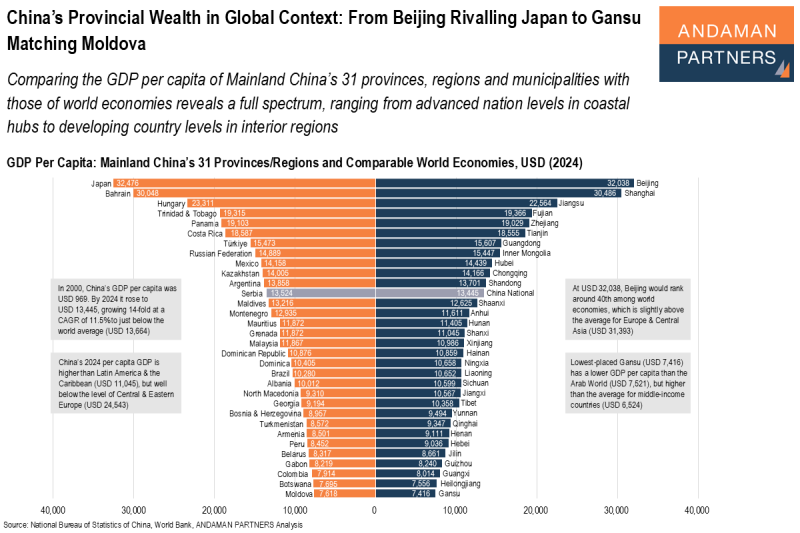
China’s Provincial Wealth in Global Context: From Beijing Rivalling Japan to Gansu Matching Moldova
Comparing the GDP per capita of China’s provinces with those of world economies reveals a full spectrum, from advanced to developing country levels.

Who Buys What From China? Five Largest Export Destinations By Category and Product
Of China’s USD 3.6 trillion in exports in 2024, these were the top five export categories and products—and the largest buyers for each.
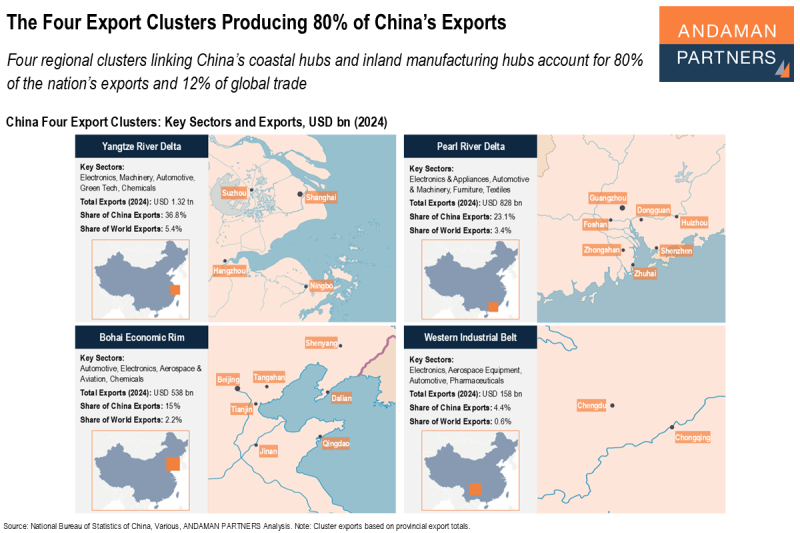
The Four Export Clusters Producing 80% of China’s Exports
ANDAMAN PARTNERS presents a summary of China’s four major export clusters.


